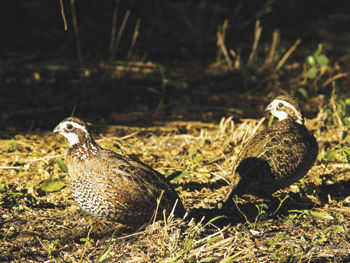HARLINGEN — The forecast is in, and quail numbers appear to be slightly down from last year.
Quail season begins Saturday and the Texas Parks and Wildlife Department rural road surveys in the South Texas Plains indicate 10.6 quail were reported per 20-mile route this summer. Last year, the average was 14 quail sightings in South Texas.
When it comes to quail populations in South Texas, it’s all about the rainfall.
Since the state came out of a serious drought in 2013, “we’ve had a run of some pretty good years,” said Leonard Brennan, the C.C. “Charlie” Winn Endowed Chair for Quail Research at the Richard M. Kleberg Jr. Center for Quail Research at TAMU-Kingsville.
“There are areas right around Kingsville and southern Kleberg County that kind of had a tough time this summer, but then you get further south in Kenedy County and down to the Valley, and I’ve heard from that part of the world that it’s really good.
“We’ve got a lot of area in South Texas that does a pretty good job of producing quail when it rains, and that’s exactly what we’ve been seeing,” Brennan added.
Statewide, 2016 was a renaissance year for quail hunting, a reminder of how good it can be when everything comes good, quail-wise.
“Specifically, weather and habitat aligned to create a ‘super boom’ year for quail production that led to exceptional hunts the likes of which had not been seen in many years,” TPWD biologists said.
This year’s quail production is expected to be adequate but not spectacular, particularly in the Valley’s region of the South Texas Plains.
“Portions of South Texas and the Rolling Plains regions were in moderate drought during mid-summer, which may have negatively impacted brood survival,” said Robert Perez, quail program leader with TPWD.
TPWD bases its projection on statewide quail surveys started in 1978 to monitor the bird’s population. This index uses randomly-selected, 20-mile roadside surveys to determine annual quail population trends by ecological region. The information helps determine relative quail populations among the regions of Texas.
The long-term loss of habitat has been a primary factor in the decline of bobwhite and scaled quail in Texas. Up until last year’s boom year, bobwhite quail populations have been declining about 5.6 percent each year and scaled quail have seen a decline of 2.9 percent annually since 1980, biologists say.
And it’s not just quail.
TPWD biologists say at least 24 other grassland birds like scissor-tailed flycatchers and meadowlarks are all in serious decline, and that since 1968, these habitat-specific species have lost nearly 40 percent of their populations despite not being hunted.
The TPWD and private groups are actively involved in improving grassland habitat by planting native grasses, and much of the funding for these efforts come from hunters.
“Things have dropped off around Texas,” said TAMU-Kingsville’s Brennan. “We are below 100,000 quail hunters anymore these days.
“But the Rolling Plains and South Texas are two of the last great places for quail anywhere,” he added.
Quail hunting season runs through Feb. 25, 2018. The daily bag limit for quail is 15, with 45 in possession. Legal shooting hours for all non-migratory game birds are 30 minutes before sunrise to 30 minutes after sunset. The bag limit is the maximum number that may be killed during the legal shooting hours in one day.
Valley quail reside on public lands, too
HARLINGEN — When it comes to quail hunting in the Rio Grande Valley, it doesn’t necessarily have to come with a fat lease fee.
The Texas Parks and Wildlife Department’s Las Palomas Wildlife Management Area is made up of 18 units with more than 3,000 acres, many of which are open to hunting doves, rabbits and hares, chachalacas and quail.
“We have public land that I manage and we do have some birds,” TPWD biologist Jimmy Stout, area manager for Las Palomas, said yesterday.
Stout said that in addition to a small-game license, hunters also are required to have upland game bird, migratory game bird and public hunt endorsements to use the properties. Extra license fees to hunt these lands statewide total about $50.
“And you need to wear orange if hunting migratory birds like chachalaca or quail,” Stout said.
Stout, a Harlingen native, said he has hunted the region for years and recommends the following units for quail: Baird, Taormina and Chapote units in Hidalgo County; Longoria Unit north of Santa Rosa; Arroyo Colorado Unit between Rio Hondo and Arroyo City; and Carrecitos, Ebony and Tucker units near San Benito; and Anacua Unit south of Santa Maria.
“Down here the properties that I have are very small, a couple of hundred acres, most of them, and when you have a hundred acres you can’t hold that many birds,” Stout said.
“All of our units have maybe three, four, five or six coveys … I tell hunters to be extremely ethical and just take two or three birds instead of wiping out the covey entirely,” Stout said.
Bobwhite quail
Year Quail observed
2017 10.16
2016 13.97
2015 20.57
2014 11.54
2013 5.76
Sightings from random 20-mile road surveys
Historic South Texas average is 6.5 quail per route
Source: TPWD





